
Does Premium Gas Really Improve Your Car’s Gas Mileage and Save You Money?
Considering the national average for a gallon of gas is hovering above $4, it’s no surprise that many drivers are looking for ways to save money. This has caused many Americans to spend a little more at the pump for 91 octane as opposed to 87. But can using premium gas really improve your car’s gas mileage?
Can you save money by using premium gas to improve your car’s fuel efficiency?

No, using premium gas won’t save you money by making your car more fuel-efficient. KHOU 11 News reports that high-octane gas is more stable than low-octane fuel. This means that it’s less likely to cause “engine knocking” when the fuel burns. This engine knocking can cause damage to high-performance engines like those used in sports cars and some luxury vehicles.
However, most modern commuter cars, like your trusty Toyota Corolla, have computers that prevent engine knocking and don’t necessitate the use of 91-octane fuel. As such, Consumer Reports recommends sticking to the manufacturer’s octane suggestion as noted in the car’s owner’s manual. Most of the time, it will be 87 octane – on that note, remember to refrain from using 85-octane fuel in any car.
The editors at Car and Driver put 91-octane fuel to the test
Car and Driver tested the difference between using 87 and 91 octane on a 2019 Honda CR-V. It served well as a good test mule since it’s powered by a turbocharged 1.5-liter engine. You would think a turbocharged engine would benefit from a higher-octane fuel. However, this one did not.
According to the publication’s testing: “Switching from 87 octane to 93 octane yielded a 7-hp gain on the dynamometer but that average was lost in the noise at the track.”
On the test track, the CR-V 0-60 mph and quarter-mile times were a tenth of a second slower when the superior liquid gold was used. And when it came to fuel economy, the CR-V test car achieved an average of 27.6 mpg on premium gas, up from 27.3 mpg on regular when driving at 75 mph.
That’s about a 1% improvement for a 21% increase in cost between the two different octanes. In essence, even during times when using premium gas can lead to any performance benefits in a commuter car, it’s significantly outweighed by the cost.
Which cars require the use of premium-octane gas?

Mainly sports cars and high-end luxury cars. If you drive an Acura, BMW, Mercedes-Benz, Audi, or basically anything with an upscale badge, then your car likely needs the premium stuff. If you’re unsure, then you can always check the inside of the fuel filler door. There is typically a sticker that will tell you the minimum octane fuel that you can use.
There are some cars on the market that benefit from using a higher-octane gas. One such example is the 2022 Mazda3 2.5 Turbo, which produces 227 hp and 310 lb-ft of torque when 87-octane is used. But when you pump the 91-octane swill into the tank, the Mazda3 Turbo kicks out 250 hp and 320 lb-ft of torque.
In that case, opting for the higher-end gas can be worth it. But considering gas prices are sky-high, you may just want to stick to regular old 87-octane gas.



